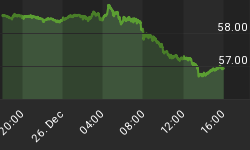Company insiders are selling in record numbers, once again. Yes, insiders have been selling for the better part of 8 months as share prices have risen, but how good could a company's prospects be if those at the controls don't see any benefit of holding onto their shares? The S&P500 has moved over 60% since the March, 2009 lows. The "bull market" hype has been nothing but a trading range for 4 months now, and over this time, the "dumb money" has been increasingly bullish while the "smart money" has shown indifference. If all this isn't enough to get you to realize the market's prospects are limited without a meaningful pullback, then maybe the actions of company insiders will. If insider expectations continue to remain low, then why should yours remain high?
The "Dumb Money" indicator, which is shown in figure 1, looks for extremes in the data from 4 different groups of investors who historically have been wrong on the market: 1) Investor Intelligence; 2) Market Vane; 3) American Association of Individual Investors; and 4) the put call ratio. The "Dumb Money" indicator is neutral.
Figure 1. "Dumb Money" Indicator/ weekly
The "Smart Money" indicator is shown in figure 2. The "smart money indicator is a composite of the following data: 1) public to specialist short ratio; 2) specialist short to total short ratio; 3) SP100 option traders. The Smart Money indicator is neutral to bearish.
Figure 2. "Smart Money" Indicator/ weekly
Figure 3 is a weekly chart of the S&P500 with the InsiderScore "entire market" value in the lower panel. From the InsiderScore weekly report we get the following: 1) "Selling increased across all market cap groups and sectors last week, pushing the Market-Wide Weekly Score to its worst level since the week ended August 11, 2009"; 2) within the S&P500, the weekly score hit its worst level since June, 2007 with selling out pacing buying by a 7:1 ratio; 3) selling increased dramatically week over week in the Russell 2000; 4) selling and lack of buying conviction picked was noticeable within the Financial, Technology, Healthcare and Basic Material sectors.
Figure 3. InsiderScore Entire Market/ weekly
Figure 4 is a weekly chart of the S&P500. The indicator in the lower panel measures all the assets in the Rydex bullish oriented equity funds divided by the sum of assets in the bullish oriented equity funds plus the assets in the bearish oriented equity funds. When the indicator is green, the value is low and there is fear in the market; this is where market bottoms are forged. When the indicator is red, there is complacency in the market. There are too many bulls and this is when market advances stall.
Currently, the indicator was headed towards a bullish signal (suggesting too many bears) but the dip buyers bought the dip early, and in all likelihood, they will be disappointed as it will take lower prices to bring about a more lasting bottom and tradeable rally.
Shorter term Rydex measures continue to suggest that these market timers are warming up to higher prices. This data, which has proved to be very actionable, is now available for a nominal yearly fee as Premium Content. This service should help you to improve your market timing!
Figure 4. Rydex Total Bull v. Total Bear/ weekly
















